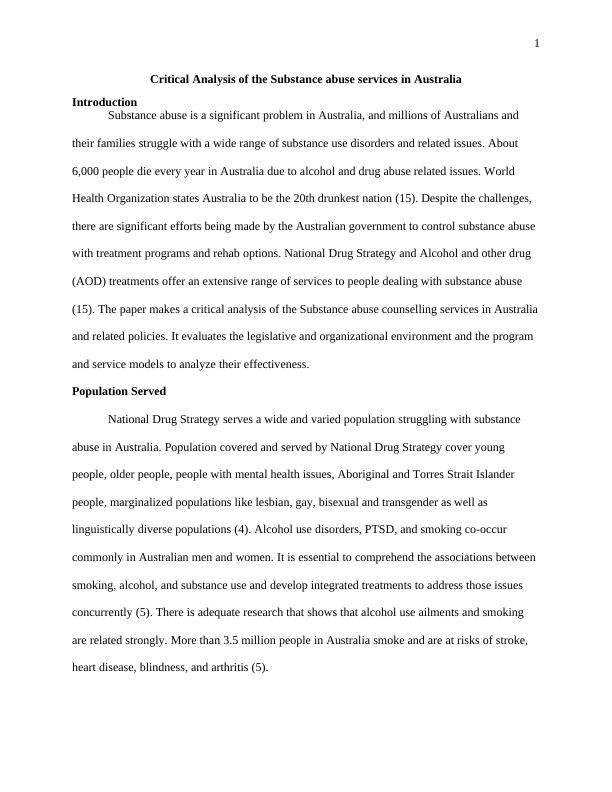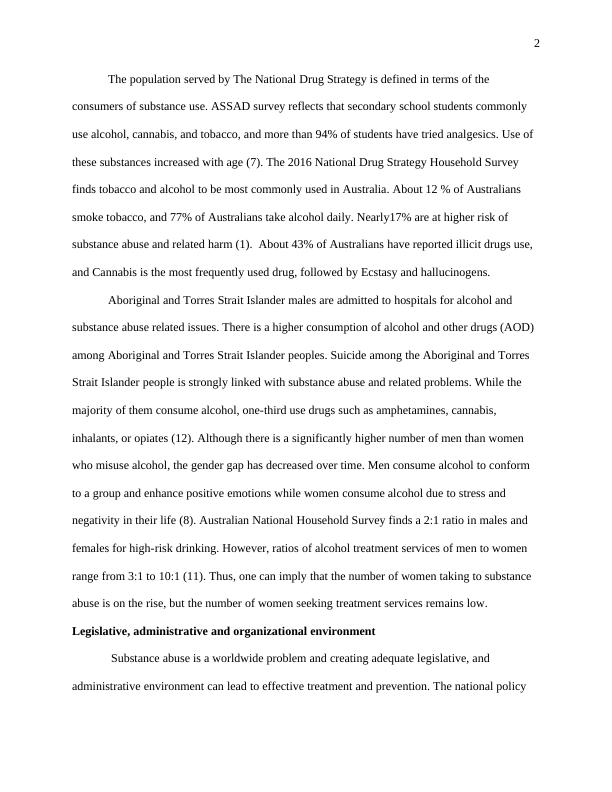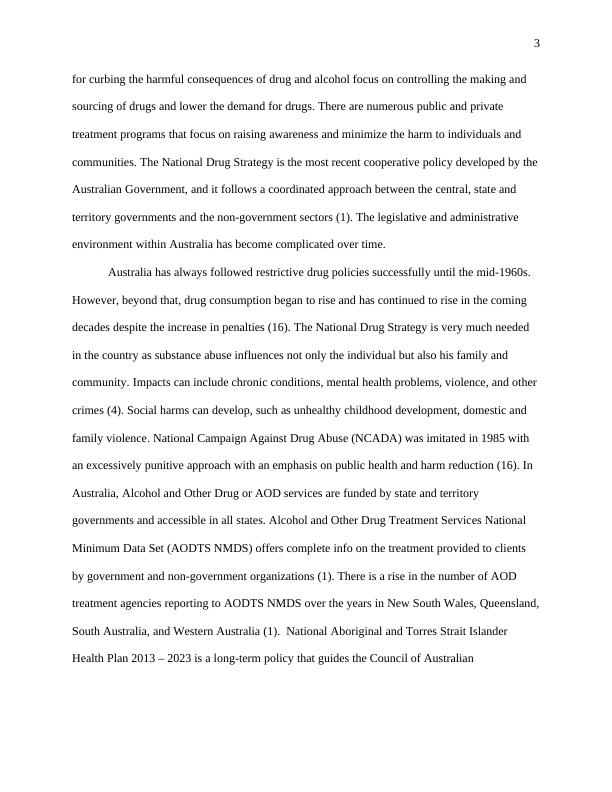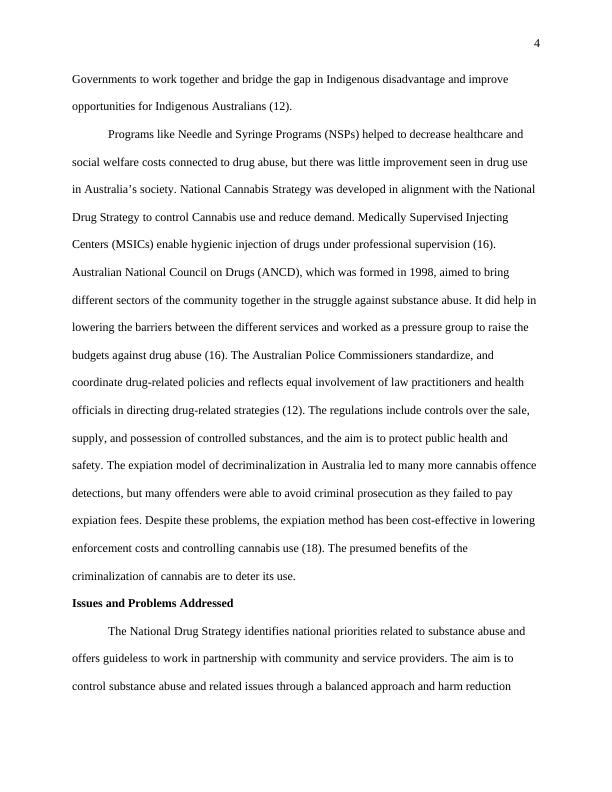Critical Analysis of Substance Abuse Services in Australia
11 Pages3346 Words2 Views
Added on 2022-12-28
About This Document
This paper critically analyzes the substance abuse services in Australia, evaluating the legislative and organizational environment, program and service models, and the population served. It discusses the issues and problems addressed and provides a critique of the field of practice. The National Drug Strategy and its impact are also examined.
Critical Analysis of Substance Abuse Services in Australia
Added on 2022-12-28
ShareRelated Documents
1
Critical Analysis of the Substance abuse services in Australia
Introduction
Substance abuse is a significant problem in Australia, and millions of Australians and
their families struggle with a wide range of substance use disorders and related issues. About
6,000 people die every year in Australia due to alcohol and drug abuse related issues. World
Health Organization states Australia to be the 20th drunkest nation (15). Despite the challenges,
there are significant efforts being made by the Australian government to control substance abuse
with treatment programs and rehab options. National Drug Strategy and Alcohol and other drug
(AOD) treatments offer an extensive range of services to people dealing with substance abuse
(15). The paper makes a critical analysis of the Substance abuse counselling services in Australia
and related policies. It evaluates the legislative and organizational environment and the program
and service models to analyze their effectiveness.
Population Served
National Drug Strategy serves a wide and varied population struggling with substance
abuse in Australia. Population covered and served by National Drug Strategy cover young
people, older people, people with mental health issues, Aboriginal and Torres Strait Islander
people, marginalized populations like lesbian, gay, bisexual and transgender as well as
linguistically diverse populations (4). Alcohol use disorders, PTSD, and smoking co-occur
commonly in Australian men and women. It is essential to comprehend the associations between
smoking, alcohol, and substance use and develop integrated treatments to address those issues
concurrently (5). There is adequate research that shows that alcohol use ailments and smoking
are related strongly. More than 3.5 million people in Australia smoke and are at risks of stroke,
heart disease, blindness, and arthritis (5).
Critical Analysis of the Substance abuse services in Australia
Introduction
Substance abuse is a significant problem in Australia, and millions of Australians and
their families struggle with a wide range of substance use disorders and related issues. About
6,000 people die every year in Australia due to alcohol and drug abuse related issues. World
Health Organization states Australia to be the 20th drunkest nation (15). Despite the challenges,
there are significant efforts being made by the Australian government to control substance abuse
with treatment programs and rehab options. National Drug Strategy and Alcohol and other drug
(AOD) treatments offer an extensive range of services to people dealing with substance abuse
(15). The paper makes a critical analysis of the Substance abuse counselling services in Australia
and related policies. It evaluates the legislative and organizational environment and the program
and service models to analyze their effectiveness.
Population Served
National Drug Strategy serves a wide and varied population struggling with substance
abuse in Australia. Population covered and served by National Drug Strategy cover young
people, older people, people with mental health issues, Aboriginal and Torres Strait Islander
people, marginalized populations like lesbian, gay, bisexual and transgender as well as
linguistically diverse populations (4). Alcohol use disorders, PTSD, and smoking co-occur
commonly in Australian men and women. It is essential to comprehend the associations between
smoking, alcohol, and substance use and develop integrated treatments to address those issues
concurrently (5). There is adequate research that shows that alcohol use ailments and smoking
are related strongly. More than 3.5 million people in Australia smoke and are at risks of stroke,
heart disease, blindness, and arthritis (5).

2
The population served by The National Drug Strategy is defined in terms of the
consumers of substance use. ASSAD survey reflects that secondary school students commonly
use alcohol, cannabis, and tobacco, and more than 94% of students have tried analgesics. Use of
these substances increased with age (7). The 2016 National Drug Strategy Household Survey
finds tobacco and alcohol to be most commonly used in Australia. About 12 % of Australians
smoke tobacco, and 77% of Australians take alcohol daily. Nearly17% are at higher risk of
substance abuse and related harm (1). About 43% of Australians have reported illicit drugs use,
and Cannabis is the most frequently used drug, followed by Ecstasy and hallucinogens.
Aboriginal and Torres Strait Islander males are admitted to hospitals for alcohol and
substance abuse related issues. There is a higher consumption of alcohol and other drugs (AOD)
among Aboriginal and Torres Strait Islander peoples. Suicide among the Aboriginal and Torres
Strait Islander people is strongly linked with substance abuse and related problems. While the
majority of them consume alcohol, one-third use drugs such as amphetamines, cannabis,
inhalants, or opiates (12). Although there is a significantly higher number of men than women
who misuse alcohol, the gender gap has decreased over time. Men consume alcohol to conform
to a group and enhance positive emotions while women consume alcohol due to stress and
negativity in their life (8). Australian National Household Survey finds a 2:1 ratio in males and
females for high-risk drinking. However, ratios of alcohol treatment services of men to women
range from 3:1 to 10:1 (11). Thus, one can imply that the number of women taking to substance
abuse is on the rise, but the number of women seeking treatment services remains low.
Legislative, administrative and organizational environment
Substance abuse is a worldwide problem and creating adequate legislative, and
administrative environment can lead to effective treatment and prevention. The national policy
The population served by The National Drug Strategy is defined in terms of the
consumers of substance use. ASSAD survey reflects that secondary school students commonly
use alcohol, cannabis, and tobacco, and more than 94% of students have tried analgesics. Use of
these substances increased with age (7). The 2016 National Drug Strategy Household Survey
finds tobacco and alcohol to be most commonly used in Australia. About 12 % of Australians
smoke tobacco, and 77% of Australians take alcohol daily. Nearly17% are at higher risk of
substance abuse and related harm (1). About 43% of Australians have reported illicit drugs use,
and Cannabis is the most frequently used drug, followed by Ecstasy and hallucinogens.
Aboriginal and Torres Strait Islander males are admitted to hospitals for alcohol and
substance abuse related issues. There is a higher consumption of alcohol and other drugs (AOD)
among Aboriginal and Torres Strait Islander peoples. Suicide among the Aboriginal and Torres
Strait Islander people is strongly linked with substance abuse and related problems. While the
majority of them consume alcohol, one-third use drugs such as amphetamines, cannabis,
inhalants, or opiates (12). Although there is a significantly higher number of men than women
who misuse alcohol, the gender gap has decreased over time. Men consume alcohol to conform
to a group and enhance positive emotions while women consume alcohol due to stress and
negativity in their life (8). Australian National Household Survey finds a 2:1 ratio in males and
females for high-risk drinking. However, ratios of alcohol treatment services of men to women
range from 3:1 to 10:1 (11). Thus, one can imply that the number of women taking to substance
abuse is on the rise, but the number of women seeking treatment services remains low.
Legislative, administrative and organizational environment
Substance abuse is a worldwide problem and creating adequate legislative, and
administrative environment can lead to effective treatment and prevention. The national policy

3
for curbing the harmful consequences of drug and alcohol focus on controlling the making and
sourcing of drugs and lower the demand for drugs. There are numerous public and private
treatment programs that focus on raising awareness and minimize the harm to individuals and
communities. The National Drug Strategy is the most recent cooperative policy developed by the
Australian Government, and it follows a coordinated approach between the central, state and
territory governments and the non-government sectors (1). The legislative and administrative
environment within Australia has become complicated over time.
Australia has always followed restrictive drug policies successfully until the mid-1960s.
However, beyond that, drug consumption began to rise and has continued to rise in the coming
decades despite the increase in penalties (16). The National Drug Strategy is very much needed
in the country as substance abuse influences not only the individual but also his family and
community. Impacts can include chronic conditions, mental health problems, violence, and other
crimes (4). Social harms can develop, such as unhealthy childhood development, domestic and
family violence. National Campaign Against Drug Abuse (NCADA) was imitated in 1985 with
an excessively punitive approach with an emphasis on public health and harm reduction (16). In
Australia, Alcohol and Other Drug or AOD services are funded by state and territory
governments and accessible in all states. Alcohol and Other Drug Treatment Services National
Minimum Data Set (AODTS NMDS) offers complete info on the treatment provided to clients
by government and non-government organizations (1). There is a rise in the number of AOD
treatment agencies reporting to AODTS NMDS over the years in New South Wales, Queensland,
South Australia, and Western Australia (1). National Aboriginal and Torres Strait Islander
Health Plan 2013 – 2023 is a long-term policy that guides the Council of Australian
for curbing the harmful consequences of drug and alcohol focus on controlling the making and
sourcing of drugs and lower the demand for drugs. There are numerous public and private
treatment programs that focus on raising awareness and minimize the harm to individuals and
communities. The National Drug Strategy is the most recent cooperative policy developed by the
Australian Government, and it follows a coordinated approach between the central, state and
territory governments and the non-government sectors (1). The legislative and administrative
environment within Australia has become complicated over time.
Australia has always followed restrictive drug policies successfully until the mid-1960s.
However, beyond that, drug consumption began to rise and has continued to rise in the coming
decades despite the increase in penalties (16). The National Drug Strategy is very much needed
in the country as substance abuse influences not only the individual but also his family and
community. Impacts can include chronic conditions, mental health problems, violence, and other
crimes (4). Social harms can develop, such as unhealthy childhood development, domestic and
family violence. National Campaign Against Drug Abuse (NCADA) was imitated in 1985 with
an excessively punitive approach with an emphasis on public health and harm reduction (16). In
Australia, Alcohol and Other Drug or AOD services are funded by state and territory
governments and accessible in all states. Alcohol and Other Drug Treatment Services National
Minimum Data Set (AODTS NMDS) offers complete info on the treatment provided to clients
by government and non-government organizations (1). There is a rise in the number of AOD
treatment agencies reporting to AODTS NMDS over the years in New South Wales, Queensland,
South Australia, and Western Australia (1). National Aboriginal and Torres Strait Islander
Health Plan 2013 – 2023 is a long-term policy that guides the Council of Australian

4
Governments to work together and bridge the gap in Indigenous disadvantage and improve
opportunities for Indigenous Australians (12).
Programs like Needle and Syringe Programs (NSPs) helped to decrease healthcare and
social welfare costs connected to drug abuse, but there was little improvement seen in drug use
in Australia’s society. National Cannabis Strategy was developed in alignment with the National
Drug Strategy to control Cannabis use and reduce demand. Medically Supervised Injecting
Centers (MSICs) enable hygienic injection of drugs under professional supervision (16).
Australian National Council on Drugs (ANCD), which was formed in 1998, aimed to bring
different sectors of the community together in the struggle against substance abuse. It did help in
lowering the barriers between the different services and worked as a pressure group to raise the
budgets against drug abuse (16). The Australian Police Commissioners standardize, and
coordinate drug-related policies and reflects equal involvement of law practitioners and health
officials in directing drug-related strategies (12). The regulations include controls over the sale,
supply, and possession of controlled substances, and the aim is to protect public health and
safety. The expiation model of decriminalization in Australia led to many more cannabis offence
detections, but many offenders were able to avoid criminal prosecution as they failed to pay
expiation fees. Despite these problems, the expiation method has been cost-effective in lowering
enforcement costs and controlling cannabis use (18). The presumed benefits of the
criminalization of cannabis are to deter its use.
Issues and Problems Addressed
The National Drug Strategy identifies national priorities related to substance abuse and
offers guideless to work in partnership with community and service providers. The aim is to
control substance abuse and related issues through a balanced approach and harm reduction
Governments to work together and bridge the gap in Indigenous disadvantage and improve
opportunities for Indigenous Australians (12).
Programs like Needle and Syringe Programs (NSPs) helped to decrease healthcare and
social welfare costs connected to drug abuse, but there was little improvement seen in drug use
in Australia’s society. National Cannabis Strategy was developed in alignment with the National
Drug Strategy to control Cannabis use and reduce demand. Medically Supervised Injecting
Centers (MSICs) enable hygienic injection of drugs under professional supervision (16).
Australian National Council on Drugs (ANCD), which was formed in 1998, aimed to bring
different sectors of the community together in the struggle against substance abuse. It did help in
lowering the barriers between the different services and worked as a pressure group to raise the
budgets against drug abuse (16). The Australian Police Commissioners standardize, and
coordinate drug-related policies and reflects equal involvement of law practitioners and health
officials in directing drug-related strategies (12). The regulations include controls over the sale,
supply, and possession of controlled substances, and the aim is to protect public health and
safety. The expiation model of decriminalization in Australia led to many more cannabis offence
detections, but many offenders were able to avoid criminal prosecution as they failed to pay
expiation fees. Despite these problems, the expiation method has been cost-effective in lowering
enforcement costs and controlling cannabis use (18). The presumed benefits of the
criminalization of cannabis are to deter its use.
Issues and Problems Addressed
The National Drug Strategy identifies national priorities related to substance abuse and
offers guideless to work in partnership with community and service providers. The aim is to
control substance abuse and related issues through a balanced approach and harm reduction

End of preview
Want to access all the pages? Upload your documents or become a member.
Related Documents
Nursing 2022 Research Paperlg...
|7
|1678
|28
Addressing SDH in Health Policy Rationalelg...
|20
|5221
|71
INDIGENOUS SUBSTANCE ABUSE PROGRAM 2 INDIGENOUS SUBSTACNE USE PROGRAM Aboriginal and/or Torres Strait Islander Alcohol Use Prevention Programlg...
|16
|4879
|416
Harm Minimization: Substance Abuse in Australialg...
|12
|2943
|244
12. Introduction. Vulnerability among the indigenous anlg...
|14
|4167
|12
Impact of Violence and Alcoholism in Aboriginal and Torres Strait Islanderlg...
|7
|1567
|78
